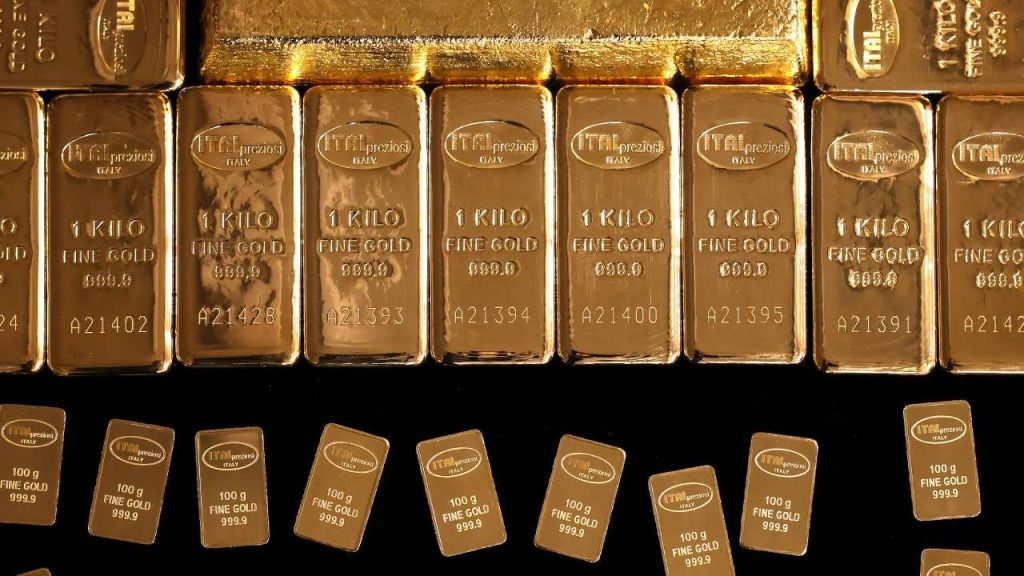The price of gold has been hitting all-time highs for more than a year, and it seems like its momentum won’t slow down. But just how good have gold’s returns been over time?
Here’s how much money you’d have now if you invested $1,000 in gold 10 years ago, as well as the average annual returns over a variety of other periods. But there’s more than one way to invest in gold — and if you choose a bad way to buy it, you can lose a huge chunk of your gains.
Here’s how gold has performed over time
Let’s get down to the cold hard returns right away, before discussing what it all means. The table below shows how much money you’d have today if you purchased $1,000 in gold at the spot price at the time noted in each column. The table also provides the total return, as well as the compound average annual growth rate, which can help make comparisons easier.
How much you would have if you invested $1,000 in gold at this time…
| Time period | 1 year ago | 3 years ago | 5 years ago | 10 years ago | 15 years ago | 25 years ago |
| Total value | $1,404.18 | $1,903.94 | $1,841.93 | $2,859.36 | $2,739.75 | $11,683.41 |
| Total return | 40.4% | 90.4% | 84.2% | 185.9% | 174.0% | 1,068.3% |
| Compound average growth rate | 40.4% | 23.9% | 13.0% | 11.1% | 7.0% | 10.3% |
Source: USAGold.com as of July 9, 2025
For example, if you’d invested $1,000 in gold three years ago, you’d now have nearly $1,904. That translates into a 90.4 percent total return and a 23.9 percent average annual return. Over the 10-year period ending July 9, 2025, gold returned about 11.1 percent per year on average.
But for some long periods, gold had low average annual returns. For example, in the five years starting July 9, 2010, gold lost more than 1 percent per year on average (or about 4 percent total). In the 10 years starting July 9, 2010, gold returned just above 4.0 percent annually on average. In other words, gold had a miserable decade from July 2010 to July 2020.
So it’s important to note how gold’s recent massive run, which began around the start of 2024, is so key to the average annual return figures in the table above. The starting and ending points can be huge factors in how good or poor the returns look. So let’s look at the same time periods, but before gold began its latest run, with returns in the table below going to the end of 2023.
| Time period | 1 year | 3 years | 5 years | 10 years | 15 years | 25 years |
| Compound average growth rate | 9.1% | 2.9% | 10.0% | 5.5% | 5.8% | 8.2% |
Source: USAGold.com. Returns to Dec. 29, 2023
What were quite good average annual returns though mid-2025 suddenly become middling returns for many periods. For example, in the three years to the end of 2023, gold returned just 2.9 percent per year, while in the 10-year and 15-year periods to 2023 year-end, gold returned a respectable but less impressive 5.5 percent and 5.8 percent annually on average, respectively.
It’s also important to note that these are the returns that you would have received if you had been able to buy and sell at the spot price of gold, without any further incremental costs, such as storage or insurance. But you may end up paying huge fees if you invest in gold the wrong way.
None of this applies to the most popular valuable coins, where the price drivers are scarcity, though it may apply to the most popular gold bullion coins.
The worst way to invest in gold
The worst way to invest in gold is to buy physical bullion. The key reason is that you’ll never be able to transact at the spot price of gold. A dealer will always charge customers more than the spot price to buy gold and will always offer clients less than the spot price to sell it. That’s how the gold dealer makes money, and it’s just how the business works, because the dealer needs a spread to make a profit. That spread has to come from the buyers and sellers of the product.
Just how much does this cost you in terms of total returns? It’s enormous in even the best case.
Using the same returns as the first table, let’s assume that you paid a 5 percent premium when buying and sold at a 5 percent discount. Here’s how much you’d have over the same periods.
| Time period | 1 year | 3 years | 5 years | 10 years | 15 years | 25 years |
| Total value | $1,270.45 | $1,722.61 | $1,666.51 | $2,587.04 | $2,478.82 | $10,570.71 |
| Difference due to spread | -$133.73 | -$181.33 | -$175.42 | -$272.32 | -$260.93 | -$1,112.71 |
| Total return | 27.0% | 72.3% | 66.7% | 158.7% | 147.9% | 957.1% |
For example, if you bought gold a year ago and then sold it, you’d have a value of $1,270.45 after factoring in the spread. You’d effectively lose $133.73 in value to the spread, turning what had been a 40.4 percent gain into a 27 percent gain — costing basically one-third of your gain.
Over a 10-year period, you would have effectively lost $272.32 due to the spread, turning what had been a 185.9 percent gain into a 158.7 percent gain. That spread ate up nearly 15 percent of the total profit on the trade. It’s a similar situation with the 25-year period, where the difference is more than $1,112. Here the spread would cost you more than 10 percent of your profit.
In even the best case, you wind up paying a huge chunk of your profit to the dealer. But you may end up paying even higher spreads if you’re trying to sell your gold quickly, you sell to a dealer with a high spread or it occurs during a time when dealers can increase their spread. Incredibly, you’ll need gold to increase nearly 10 percent just to break even on your purchase!
For these reasons, buying gold bullion is a sucker’s bet on gold prices. Here’s a better option.
The best way to invest in gold
If you’re looking to invest in physical gold, a better way to do it is to buy a gold exchange-traded fund (ETF). With a gold ETF that invests in physical gold, you avoid the worst elements of buying physical bullion — storing and insuring it, the huge spreads — while being able to buy and sell it at fair market value at any time the market is open.
Of course, you’ll pay something for these advantages — namely, the ETF’s expense ratio. The expense ratio is calculated as a percentage of your investment in the fund, and it’s deducted seamlessly from the fund for each day that you own it. One of the best physical gold funds is the SPDR Gold Shares ETF (GLD), which charges a 0.4 percent expense ratio.
Let’s do a quick comparison between the returns on this fund and those of buying bullion yourself over the past year.
| Buying physical bullion | Buying a gold ETF | Difference | |
|---|---|---|---|
| After-fee returns over 1 year | $1.270.45 | $1,398.56 | $128.11 |
| Effective percentage return | 27.0% | 39.9% | 12.9 percentage points |
As you can see in the table above, you’ll lose 0.4 percent of your total investment in the fund, which is calculated here as a 0.4 percent reduction in the overall value at year-end for simplicity. In other words, with the ETF, you get to keep nearly 99% of your profits, whereas by buying gold bullion, you’d need to give up about one-third of your gains over this past year.
Now, it’s not all peaches and cream with the ETF, either. Over time, the expense ratio will eat at your returns, too — in the case of the fund mentioned above, 0.4 percent per year. But that beats the heck out of paying 5 percent extra on the buy and losing 5 percent on the sell — effectively many years’ worth of the fund’s expense ratio — every time you want to transact.
Of course, there are other ways to wager on gold, including futures, as well as gold miners’ stocks. But in the head-to-head matchup for investing in physical bullion, buying gold through an ETF is so much better than buying the bullion yourself and getting taken to the cleaners on the spread.
Bottom line
Gold has long been known as a store of value, particularly in harder economic times, but many investors prefer to invest in cash-generating investments. The legendary superinvestor Warren Buffett has long recommended that investors purchase a low-cost index fund based on the S&P 500 stock index, which has a strong record of returns over long periods.
Editorial Disclaimer: All investors are advised to conduct their own independent research into investment strategies before making an investment decision. In addition, investors are advised that past investment product performance is no guarantee of future price appreciation.
Why we ask for feedback
Your feedback helps us improve our content and services. It takes less than a minute to
complete.
Your responses are anonymous and will only be used for improving our website.
Help us improve our content
Read the full article here









